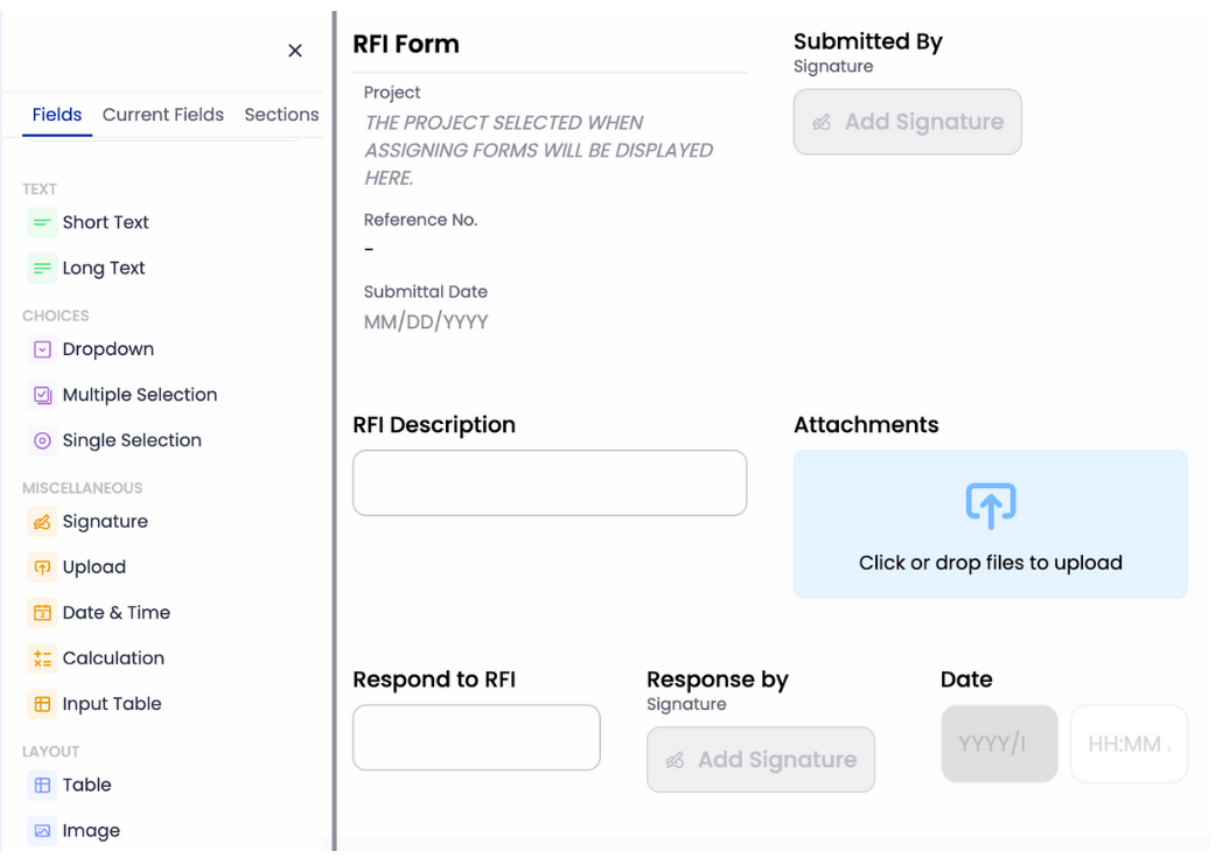RFI Template & Form: RFI in Construction Guide
Get answers faster with RFI in construction industry best practices. Learn how to enhance project management and reduce delays by improving how you submit an RFI and track every RFI response from start to finish.
by Sam Chen
|
Let’s be honest—RFIs can be a real pain. Traditional request for information RFI processes are slow. Paperwork piles up, requested information gets lost, and communication breaks down when there’s no documentation to support the question. Sound familiar?
In the construction industry, time is money. Poor project management and unclear project plans waste resources and affect progress. That’s why the right RFI template and digital tools are essential for every general contractor, project owner, and team member. If you’ve ever waited days for an RFI response, or had to re-send the same form multiple times, it's time to rethink how you’re sending an RFI.
This guide breaks down the biggest pain points and shows how construction management platforms—like GoBuid—can transform RFIs into a fast, organized, and real-time system that actually saves time.
Common Challenges with RFIs in Construction Projects
RFI Mistakes That Cause Delays
Unclear, incomplete, or vague RFIs lead to frustration. The most common mistake? Submitting an RFI without context. Without key details, RFIs bounce between departments or are ignored. Multiply that by dozens of requests, and your project’s timeline is in trouble. A clear, organized request for information form with an assigned RFI number is a small step that has a big impact.
Miscommunication in RFI Details
Let’s say the HVAC subcontractor submits a question about ceiling clearances. If the request for information form is misunderstood or misinterpreted, it may result in installation errors and costly rework. Most of this is avoidable. Properly structured RFIs help ensure that requested information is delivered correctly the first time.
Too Many RFIs? Here’s How to Manage the Chaos
Hundreds of RFIs in a single project isn’t uncommon. But trying to manage that volume manually is a recipe for disaster. Missed forms, delayed responses, and confusion around status updates become daily obstacles. A digital RFI system that categorizes requests by discipline and urgency helps your team stay in sync, especially on fast-paced construction projects.
Slow RFI Replies Hurt Progress
Every hour you spend waiting on an RFI response is time lost on-site. Many teams still rely on outdated systems, like spreadsheets and email chains. Switching to a platform with real-time notifications, cloud syncing, and digital routing ensures that your RFI template reaches the right person quickly—and gets a faster response.
Miscommunication on the Jobsite
When RFIs aren’t centralized, construction professionals often work with outdated or incomplete information. That leads to misaligned installations, repeated work, and finger-pointing. Housing every request for information form in one cloud-based system allows team members to see the same data in real time—cutting down miscommunication.
Incomplete Documentation
RFIs submitted without backup documents are a common issue. Drawings, photos, and site sketches help reviewers make faster and more accurate decisions. Make sure your RFI template allows you to include in an RFI everything needed to gather information and provide context for the issue.
Lack of Accountability Slows Everything Down
If no one knows who created the RFI or when it was sent, it's easy for that request to get overlooked. An effective RFI system includes status tracking, timestamps, and digital signatures to make the audit trail crystal clear. Every construction project benefits from this level of visibility.
RFI Template Example: Creating an Effective RFI

An effective RFI starts with a solid RFI template. Here’s what to include:
- Simple Layout: Use an easy-to-read format that breaks down the issue clearly.
- Reference Fields: Tie the RFI to specific drawings, details, or project plans.
- Signature Fields: Digital signatures for sender and receiver establish accountability.
- Attachments: Add site photos or spec sheets to clarify the issue.
- RFI Number: Assign a unique identifier to every RFI to avoid duplication or confusion.
- Real-Time Notifications: Alerts that notify the assigned party instantly can dramatically improve response times.
Cloud Storage Keeps Everything Within Reach
With mobile access and cloud backup, you’ll never lose track of a request for information form again. Thousands of RFIs can be archived, filtered, and accessed from any device—giving construction professionals the flexibility to work on the go. It also saves time and ensures nothing slips through the cracks.
GoBuid: More Than Just an RFI Template
GoBuid isn’t just a platform to manage request for information RFIs. It includes over 30 templates that support everything from safety reporting to billing. In addition to a free RFI template, you’ll find forms for:
- e-PTW (Electronic Permit to Work)
- AIA Billing Forms
- RFA (Request for Approval)
- Site Inspection Reports (ITP)
- Daily Logs
- Safety Checklists
- Request for Proposal (RFP)
Whether you’re a general contractor or project owner, every form is fully customizable to suit your workflow.
👉 Try all features free for 30 days
Conclusion
RFIs in construction don’t have to be frustrating. A well-organized system—with an effective RFI template, cloud-based access, and real-time response tools—keeps your project management sharp, your team members informed, and your schedule on track.
From improving how you submit an RFI to structuring better communication across departments, RFIs can become a strength—not a weakness—in your process.
Don’t just manage RFIs. Master them.
FQA about RFI template
1. What should be included in an effective RFI template?
An effective RFI template should include an RFI number, the subject of the request, reference documents, location details, the specific question, and areas for attachments, signatures, and responses. This structure ensures accountability and saves time during the review process.
2. Can I use a free RFI template for my construction projects?
Yes, many platforms—including GoBuid—offer a free RFI template designed for use in various construction projects. These templates are customizable, mobile-friendly, and help standardize how you handle RFIs across your team.
3. How can real-time RFI tracking benefit my team members?
Real-time RFI tracking allows team members to instantly view submitted requests, monitor status updates, and respond quickly. This digital workflow reduces delays, ensures accountability, and keeps everyone aligned on project plans.
